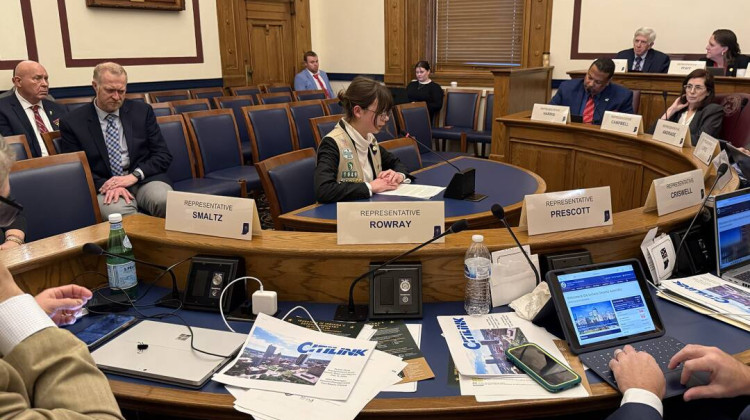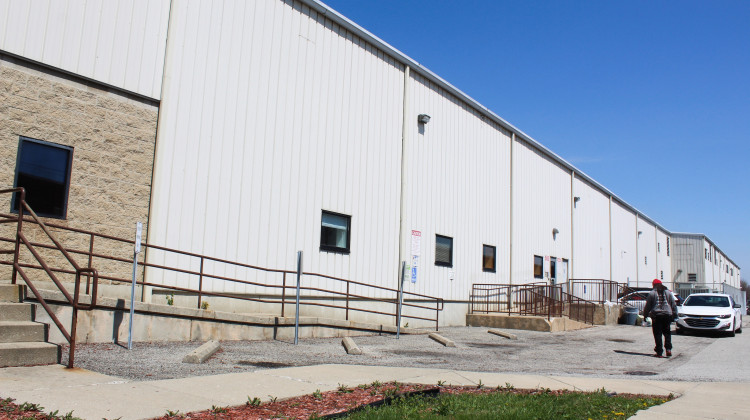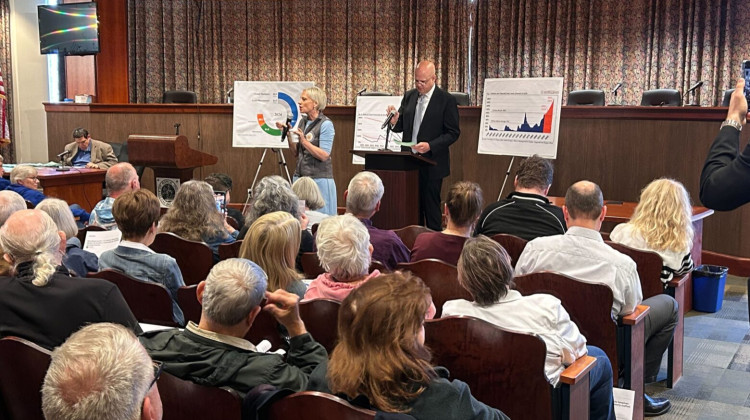
Patrons use the free computer and internet services available at Central Library in Indianapolis.
Sydney Dauphinais/WFYIIn March 2020, Herron-Riverside High School Head Katie Dorsey said – “it was like the floodgates opened.”
When instruction went virtual, the demand for support to access the internet and have a working device was so strong, right away, they knew they had to mobilize.
“Families would tell us… yes, we have a cell phone plan. But we don't have unlimited data. And it's never been a problem because we haven't had to be home using WiFi eight hours a day for our students to access school. And we can't afford the buy up plan to get unlimited data,” Dorsey said that was “a very common thing.”
The pandemic motivated schools to address the fact that broadband is either cost prohibitive or non-existent in many neighborhoods, urban and rural, and that has long put many students at a disadvantage.
“Students just weren't doing the homework that required internet access at home, they would just wait until they were at school where they had internet, or they would go to public places,” Dorsey said.
Research from Ball State University estimates more than 40,000 Indiana households with school-age children lack a dial-up internet subscription or broadband access at home. Wireline broadband – the preferred method of remote learning – is even less accessible.
Internet isn’t federally subsidized like water service or electricity. Individual states decide if and how they will regulate broadband access.
When Indiana deregulated it 15 years ago, competition between providers spiked, which drove up prices in urban communities. In rural areas, companies did not prioritize expansion because it is expensive to install fiber in remote places, and there are fewer customers to pay for it.
Many hope incoming federal money will provide a solution without regulation.
The $1.2 trillion federal Infrastructure Investment and Jobs Act includes a $65 billion investment in broadband infrastructure and ways to help low-income households afford a broadband connection when one is available. More than $100 million is slated to improve broadband access in Indiana.
But many experts say it may not help all who need it most. It is possible the funds will be dedicated mostly to expanding the broadband network in rural areas. That could leave low-income urban families in the digital gap.
Economic setback
Lack of digital access is a huge economic disadvantage, in many ways laid bare during the pandemic, when almost everything had to be remote – education, health access and job access, to name a few.
As an economics professor and director of the Center for Business and Economic Research at Ball State University Michael Hicks researches the effect of public policy on state and local economy. He said that when some schools closed in 2020, they resorted to doing paper mailings in order to teach classes.
“So teachers were bundling up information in envelopes and mailing it to their kids because there was no broadband available and no technology for students in those primarily rural school corporations,” Hicks said.
The disadvantages extend beyond the school system. Hicks says the digital divide impedes progress for low-income households. Not only is it difficult to access equitable education, but it’s hard to utilize government services or search for open jobs.
“If you don't have broadband, you're immediately excluded from 15% of all job opportunities that are available in America right now,” Hicks said. “If you don't have broadband, you're gonna have to go to the library just to apply for a job, but you certainly can't work at home.”
Broadband access isn’t an issue solely in rural areas – but as of right now, that’s where the state is directing the federal money.
Brookings Institute researcher Nicol Turner-Lee said policymakers need to inspect what the rural landscapes look like compared to urban areas. She said the digital divide should be treated as an economic divide, rather than a geographic divide, because that’s what it is.
The data from Ball State indicates disparities are particularly harsh for people already facing socioeconomic disadvantages. It shows single-parent households, households with parents not in the workforce, low-income households, and households that do not speak English at home are all far less likely to have internet access.
Brookings Institute analysis of same study shows three times the share of households with incomes of less than $25,000 a year — 57% of them — lack broadband as those earning more than $100,000. Similarly, renters are around 15% more likely to lack broadband than homeowners.
“We've had this problem for a really long time,” Turner-Lee said. “It's just taken this global health crisis for us to value this as a critical infrastructure asset, and one in which we have to say to ourselves, what does life look like when you're digitally invisible?”
In order to address the problem, Turner-Lee said, solutions need to begin at the community level. She said the federal infrastructure bill is a huge opportunity, and she hopes states will use those resources equitably and serve those most economically disadvantaged first.
State efforts to close the gap
The federal Infrastructure Investment and Jobs Act, passed by the Biden administration in November of last year, is not the only assistance in the pipeline. But the state’s existing efforts also prioritize the gap in rural areas.
The Next Level Connections program was established in 2019. The state-run program is an investment of $270 million to expand broadband access and adoption. It provides grants to internet providers to install broadband for projects that improve service for households, business and institutions.
When the pandemic hit a year later, the state used federal funds to build the Indiana Connectivity program. Rather than giving money to providers to install broadband in specific areas, residents can ask the state themselves.
The first round of the program awarded more than $650,00 to expand broadband to 253 addresses across 40 counties. That program is currently in its second round of grants.
Lt. Gov. Suzanne Crouch heads Indiana’s Office of Rural Affairs and said many people are just out of broadband reach.
“So maybe their neighbor, a half a mile or three quarters of a mile away has connection, but they can't get it,” Crouch said.
She said most people that currently benefit from Next Level Connections and Indiana Connectivity Programs are those living in rural areas. She said as of right now, there aren’t plans to prioritize the needs of those in the gap because they cannot afford it.
Education leaders including Herron-Riverside’s Katie Dorsey hope there will be more investment from the government level. Indianapolis Public Schools provided access for families who could not afford it during the pandemic, and she said she doesn’t think it’s the best use of resources for schools to bear the weight of the broadband problem.
“I think we often find ourselves saying, ‘Gosh, I can't believe schools are the solution to this,’” Dorsey said. “I hope that the federal and state funding that is going toward this can help maybe solve this whole picture scale and not just, you know, individual students and families being connected.”
Contact WFYI economic equity reporter Sydney Dauphinais at sdauphinais@wfyi.org. Follow on Twitter: @syddauphinais.
 DONATE
DONATE






 Support WFYI. We can't do it without you.
Support WFYI. We can't do it without you.